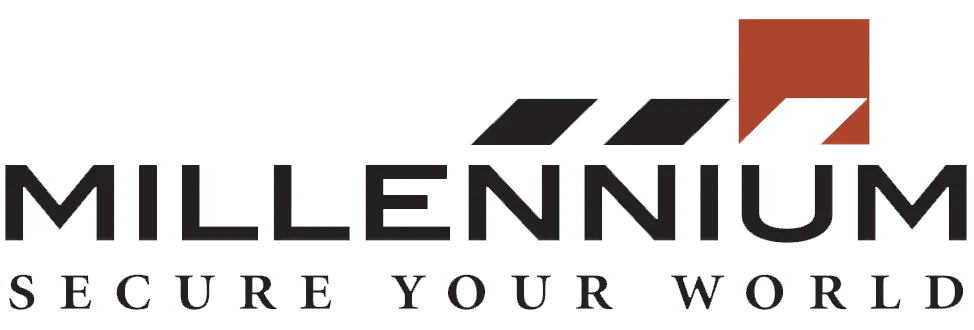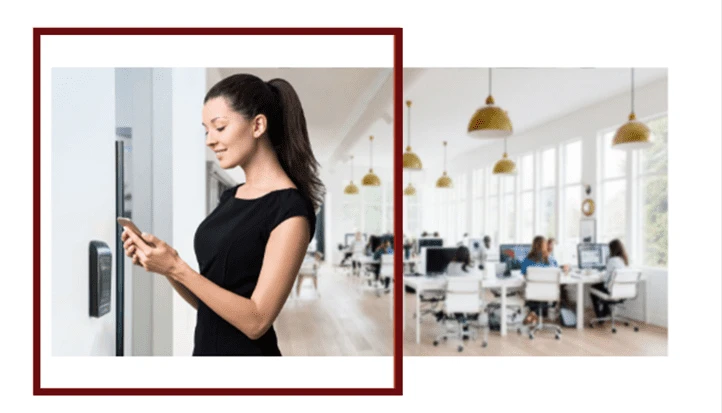Peace of Mind, Delivered: How Remote Access Control Frees Airbnb Hosts from On-Site Stress

The holiday season brings a flurry of travel—and for Airbnb hosts, that means packed calendars, back-to-back bookings, and the pressure to deliver five-star experiences. But with guests arriving at all hours and properties spread across neighborhoods or even cities, managing access for every unit can become a logistical nightmare. Enter remote access control: a game-changing feature that empowers Airbnb owners to provide seamless, secure, and contactless entry without ever needing to be on-site. Whether you’re managing a high-rise downtown, a collection of condos in resort areas, or a portfolio of single-family rentals, remote access tools help you scale operations, reduce risks, and deliver consistent experiences across every location. Why Holiday Hosting at Scale Needs Smarter Access Holiday travel is unlike any other season. It often includes: Late-night or early-morning arrivals across multiple listings Last-minute bookings and rapid turnover High guest expectations for smooth, contactless check-ins Multiple staff, cleaners, and vendors accessing various sites Traditional access methods like physical keys, lockboxes, or keypads quickly break down at scale. You can’t be everywhere at once. Remote access control changes that by giving you centralized, real-time control over every door in your portfolio. Real-Time Remote Access Control for Every Location Through a cloud-based platform, large-scale Airbnb operators can: Send digital keys to guests, cleaners, or contractors at any property Grant or revoke access instantly, from any location Assign time-based permissions for check-ins, cleanings, or service visits Monitor entry logs across all units in real time This level of control allows operators to streamline processes, cut down on errors, and provide consistent service regardless of how many listings they manage or where they’re located. Guest Check-Ins Without the Chaos Imagine you have 10 guests checking into 5 different units across the city on the same day. With remote access control, you: Schedule each guest’s digital key to activate at the right time Avoid physical key handoffs or travel between properties Receive instant confirmation when guests arrive You stay in full control, from one dashboard, without leaving your desk. Cleaner and Contractor Access That Scales With You Whether you work with in-house cleaning teams or third-party services, access management becomes seamless. Assign unique credentials that: Only work during assigned time slots Are limited to specific doors or buildings Can be revoked or reassigned in seconds Contractors can also be granted one-time or recurring access for seasonal maintenance or emergency work—no need to meet them in person or leave units vulnerable. Download the Cloud Access Control Checklist your 15-step, printable guide to building a secure, scalable, and cloud-ready system. Includes: PoLP setup, MFA guide, permission audit worksheet + a bonus printable template. Click Here Centralized Monitoring Across All Properties One of the most valuable features for multi-property owners is centralized visibility. With real-time audit logs and customizable alerts, you can: Track who entered each property and when Detect unusual activity across any door Quickly respond to lockouts or access issues remotely Whether you’re overseeing 5 doors or 500, this unified system helps maintain high standards and fast service. Building Trust With Consistent, Secure Entry Guests value consistency, especially across multiple stays or group bookings. Mobile access provides: A familiar, professional check-in experience No lost keys, reused codes, or security risks Contactless convenience that’s perfect for modern travel And for operators, it’s a scalable way to uphold safety, brand standards, and reputation across diverse properties. Conclusion: Holiday Hosting at Scale, Made Simple Remote access control isn’t just a tool—it’s the foundation for scalable, efficient, and secure Airbnb operations. Whether you’re welcoming 2 guests or 200, managing properties near or far, the ability to oversee access from anywhere transforms how you do business. For large-scale hosts and professional operators, this isn’t a luxury—it’s a necessity. Looking to upgrade your access strategy? Discover how Millennium’s access control system empowers Airbnb property managers to streamline multi-site operations, enhance guest experiences, and grow with confidence — during the holidays and every season. Millennium is a scalable, hosted, access control platform that services any type of real estate. Our cloud-based solution allows managers and tenants to efficiently manage their physical security from anywhere while enhancing experience and driving profitability.
Hospitality Reimagined: How Hotel Mobile Key Systems and Mobile Access Control Are Transforming Guest Experience and Loyalty

In today’s fast-evolving hospitality landscape, convenience, personalization, and safety are no longer luxuries — they’re expectations. The traditional hotel experience of waiting in line for check-in, juggling keycards, and signing paperwork is being replaced by contactless, app-based solutions that redefine how guests interact with spaces. Among these innovations, mobile access control stands out as a transformative technology, reshaping not only how guests enter rooms but also how they perceive the brand itself. Hotels, resorts, and co-living spaces are realizing that the door to brand loyalty literally starts at the door — and the key is now digital. From Keycards to Smartphones: The Shift to Mobile Credentials The familiar plastic keycard has long been a staple of hotel security systems. Yet, it comes with challenges — cards get lost, demagnetized, or duplicated, and reissuance adds unnecessary administrative costs. In contrast, hotel mobile key systems powered by digital room keys let guests access rooms, gyms, or private lounges directly through their smartphones. This shift is not just about convenience; it’s about creating a frictionless experience. Guests can complete contactless hotel check-ins, receive digital keys before arrival, and head straight to their rooms without waiting at the reception desk. For hotels, this means reduced front-desk load, improved operational flow, and fewer physical touchpoints — a major plus in the post-pandemic world. Personalization and Guest Engagement Through Mobile Access The hospitality industry is now using mobile access control systems not only for security but for enhancing guest engagement. When integrated with loyalty apps and property management systems (PMS), mobile credentials become part of a connected ecosystem. Guests can unlock their room, adjust lighting, set room temperature, and even order room service — all from their phones. This seamless integration makes guests feel recognized and valued. Personalized in-app experiences, special offers, and loyalty rewards tied to mobile credentials increase brand loyalty in hospitality, making guests more likely to return. For instance, a repeat guest might receive an automatic upgrade notification or digital welcome message — subtle gestures that build emotional connections and long-term satisfaction. Operational Efficiency and Security Benefits for Hotels For hoteliers, mobile access control in the hospitality industry isn’t just about guest convenience — it’s a game-changer for operations. Traditional keycards require manual handling, auditing, and constant replacement. Mobile credentials, on the other hand, can be managed from a centralized cloud platform, making it easier to grant or revoke access instantly. A modern hotel security system built on mobile credentials reduces administrative overhead while tightening access control for both guests and staff. Security teams can monitor real-time entry logs, identify anomalies, and ensure compliance with building security standards. Additionally, smart access control systems eliminate the risk of key duplication and help maintain detailed audit trails for every access event — critical for compliance and accountability. Data Security and Guest Trust: Protecting Access in the Digital Age The move toward mobile doesn’t mean compromising on safety. In fact, today’s mobile access control hospitality solutions are built on strong encryption and cloud-based security frameworks. Each digital key is unique, time-bound, and stored securely within the guest’s device. Leading systems, such as Millennium Ultra, comply with stringent data protection and cybersecurity standards, ensuring end-to-end encryption and secure credential management. With these protections in place, hotels can confidently adopt contactless solutions without exposing guests to risk. Building this level of trust is essential for fostering loyalty — when guests feel secure, they’re far more likely to engage digitally and recommend the brand to others. Download the Cloud Access Control Checklist your 15-step, printable guide to building a secure, scalable, and cloud-ready system. Includes: PoLP setup, MFA guide, permission audit worksheet + a bonus printable template. Click Here Real-World Applications: Redefining the Guest Journey Imagine arriving at a resort after a long flight and skipping the front desk entirely — your phone already holds your digital room key. You walk straight to your suite, open the door, and the room welcomes you with preferred lighting and temperature settings. During your stay, the same app gives you mobile access to the pool, spa, and exclusive lounge. This isn’t a futuristic scenario — it’s the reality many hotels are already adopting. Co-living spaces, boutique hotels, and resorts are using mobile credentials for hotels to enhance convenience, reduce physical contact, and align with the digital expectations of modern travelers. The result? Higher satisfaction scores, smoother operations, and stronger brand differentiation. Why Mobile Access Builds Long-Term Brand Loyalty Guest loyalty in hospitality isn’t just about points or perks — it’s about experiences that feel effortless and personal. By investing in mobile access control, hotels send a clear message: they value guest time, safety, and convenience. When guests can trust that every interaction — from entry to checkout — will be seamless and secure, they form emotional bonds that drive repeat bookings and word-of-mouth referrals. In an industry where experiences define reputation, mobile access systems are helping hospitality brands deliver both efficiency and empathy — two key drivers of loyalty in the digital age. Conclusion: The Future of Guest Experience Is in Their Hands The hospitality industry stands at the intersection of technology and human connection. Mobile access control represents more than just a new security feature — it’s a strategy for crafting modern, memorable, and secure guest experiences. By replacing outdated keycards with intuitive, app-based access, hotels can enhance trust, streamline operations, and strengthen their brand identity. Millennium Group’s mobile access solutions, including the advanced Millennium Ultra platform, empower hospitality leaders to embrace this transformation. From secure cloud management to seamless guest integration, these systems ensure that the future of hospitality is not just smart — it’s truly personal. Millennium is a scalable, hosted, access control platform that services any type of real estate. Our cloud-based solution allows managers and tenants to efficiently manage their physical security from anywhere while enhancing experience and driving profitability.
The $100 Billion+ Problem: How Unified Access Control and Physical Security Are Essential for Retailers
Introduction: The Rising Cost of Retail Crime Retail crime has evolved from isolated shoplifting incidents into a $100 billion+ nationwide problem. According to the National Retail Federation and Investopedia, U.S. retailers lost more than $112 billion in 2022 due to theft, shrinkage, and organized retail crime (ORC). For store owners and retail chains alike, these numbers aren’t just statistics — they represent shrinking profit margins, eroded customer trust, and increasing operational risk. As retail environments become more complex, from open layouts to 24/7 e-commerce integration, traditional security models are failing to keep up. To truly protect inventory, employees, and customers, retailers must adopt unified access control and integrated physical security systems that work seamlessly together. The Real Cost of Retail Crime for Store Owners Retail crime doesn’t just impact merchandise—it affects every layer of a store’s operation. Direct losses from theft and shrinkage cut into profit margins, but the indirect costs are often even higher. These include increased insurance premiums, staff turnover, and the expense of manual investigations. Independent retailers often face the hardest hit, as each stolen product directly reduces their limited revenue. Larger retail chains, while better equipped technologically, struggle with maintaining consistent security standards across multiple locations. For both, the message is clear: reactive measures like traditional cameras or unmonitored alarms aren’t enough. Loss prevention strategies must now integrate access control for retail stores, combining surveillance with credential-based entry, staff accountability, and centralized reporting to reduce both theft and internal fraud. The Rise of Organized Retail Crime and Complex Threats Organized Retail Crime (ORC) has become one of the biggest challenges for U.S. retailers. The U.S. Chamber of Commerce reports that over 70% of retailers have experienced a rise in ORC incidents, with average losses nearing $700,000 per $1 billion in sales. These groups are increasingly sophisticated—coordinating theft rings, exploiting store vulnerabilities, and reselling goods online. But it’s not just external actors; insider theft and return fraud also contribute significantly to shrinkage. For multi-store chains, these issues multiply as inventory and personnel move between sites. Without a unified physical security system that centralizes access permissions, video analytics, and alert mechanisms, retail security teams often react too late—after losses have occurred. Why Traditional Security Measures Are No Longer Enough Legacy systems such as standalone CCTV or simple lock-and-key methods once sufficed for small retail stores. But with self-checkout systems, automated stockrooms, and multi-channel operations, these outdated tools cannot offer complete visibility or control. Traditional systems are reactive, identifying incidents only after damage occurs. Moreover, they lack integration — meaning that access logs, surveillance footage, and alarms operate in silos. This separation makes it nearly impossible to correlate entry data with suspicious behavior in real time. To combat today’s retail threats, businesses must adopt unified access control systems that merge door access, surveillance, intrusion detection, and analytics into one ecosystem—enabling proactive threat detection and faster response. Unified Access Control and Physical Security — What It Means Unified access control combines multiple physical security layers—such as door readers, biometric access, mobile credentials, and surveillance—into a single management platform. This allows retailers to monitor, control, and audit every entry point across multiple stores from one dashboard. In a unified system: Each employee has role-based access permissions. Access control integrates with video systems to match identity with behavior. Alerts trigger when unusual activity occurs, such as after-hours entries or repeated failed access attempts. Such integrated retail security systems don’t just deter theft—they help optimize operations, enhance staff safety, and provide an auditable trail for compliance or insurance claims. Unified access control goes beyond basic entry management — it’s about bringing every physical security element together under one intelligent ecosystem. When a door opens, a camera records; when a restricted zone is accessed, analytics flag it in real-time. This synchronization allows for faster verification and more efficient security oversight. For retail chains with hundreds of doors, employees, and contractors, such centralization eliminates blind spots. It ensures that store managers, regional heads, and security teams have complete visibility across all locations—reducing insider threats, unauthorized after-hours entries, and unrecorded activity. In essence, unified security doesn’t just protect — it empowers decision-making and accountability across retail operations. Download the Cloud Access Control Checklist your 15-step, printable guide to building a secure, scalable, and cloud-ready system. Includes: PoLP setup, MFA guide, permission audit worksheet + a bonus printable template. Click Here Key Components Retailers Should Deploy A comprehensive retail security solution should include: Role-Based Credentials: Different permissions for staff, managers, vendors, and cleaners. Mobile Access Control: Employees can unlock secured areas via smartphones, reducing the need for physical keys or cards. Video and Access Integration: Combine access logs with live or recorded footage for incident verification. Cloud-Based Management: Enables central monitoring of multiple stores, ideal for retail chains. Analytics and Reporting: Dashboards that visualize shrink trends, access violations, and security incidents. Together, these technologies form a unified security architecture that allows retailers to detect, deter, and respond to threats instantly. A comprehensive retail security solution should combine flexibility, scalability, and integration. Beyond core access readers and cameras, retailers should consider advanced AI-enabled analytics, occupancy monitoring, and automated alerts for anomalies such as forced entries or prolonged door openings. Other emerging components include cloud credentialing portals, where administrators can instantly revoke access or issue digital badges, and visitor management modules that integrate with HR or vendor scheduling systems. When combined, these components create a living, adaptable security environment — one that evolves as threats change. Ultimately, a modern access control ecosystem for retail stores should strike the right balance between customer convenience, employee trust, and uncompromised protection of people and assets Implementation Roadmap for Retail Chains and Independent Stores Conduct a Security Audit: Identify critical areas like stockrooms, POS systems, and delivery bays. Map Access Zones: Define who can enter which zone, when, and under what conditions. Select Scalable Solutions: Opt for access control systems that integrate easily with existing video and alarm infrastructure. Prioritize Data Protection: Ensure encryption, multi-factor authentication, and cybersecurity best practices. Train Employees:
Haunted by Mistakes: Halloween Night Scenarios That Access Control Could Have Prevented

Halloween night is full of spooky surprises —some harmless, others not so much. Between trick-or-treaters, after-hours events, and costumed chaos, security teams often find themselves reacting to situations that could have easily been avoided. From break-ins disguised as pranks to parties that spiral out of control, here are a few realistic Halloween-night security scenarios that access control could have turned into nothing more than ghost stories. 1. The Costume Party Break-In That No One Noticed It was supposed to be a private office Halloween party — just employees and their families. But when everyone’s in costume, it’s hard to tell who’s who. Amid the laughter and music, two uninvited guests in masks wandered in unnoticed. By the time anyone realized they didn’t belong, a few laptops and personal items had vanished. If a smart access control system had been in place, this could have been avoided. With credential-based access or temporary digital passes, only registered employees and approved guests would have been able to enter. Real-time monitoring and entry logs would have alerted facility staff to unauthorized access — preventing the “ghost guests” from slipping in at all. Beyond access management, such systems can integrate with event registration platforms, syncing guest lists automatically to eliminate manual errors. Notifications could be triggered the moment an unverified badge or mobile credential is used, allowing on-site teams to respond discreetly before any loss occurs. Even better, video integrations can provide visual verification — matching credentials to faces for an added layer of assurance. With access control intelligence working silently in the background, the party stays fun, festive, and secure. 2. The Haunted Hotel That Went a Little Too Dark At a themed Halloween event in a boutique hotel, staff dimmed the lights to create a spooky atmosphere — but that also created a security blind spot. Someone slipped into a restricted maintenance corridor and tampered with the power system, plunging an entire floor into darkness. Guests panicked, and the cleanup took hours. A cloud-based access control platform could have locked down staff-only areas automatically, ensuring only authorized personnel could enter. Integrated smart cameras would have detected unusual movement in off-limits zones, alerting security before things literally went dark. In addition, access systems can pair with lighting and HVAC automation to maintain situational visibility during themed events. For example, doors that detect motion in unauthorized areas could temporarily trigger emergency lighting or send instant alerts to mobile dashboards. These integrations ensure guest experiences remain immersive but safe — balancing ambiance with awareness. By combining access control with environmental monitoring, hospitality teams can host memorable experiences without the risk of a real horror story. 3. The Neighborhood Prank That Got Out of Hand A gated community decorated for Halloween found itself the target of overzealous pranksters. Teens managed to open the side gate using an old remote, sneaking in to play “ghost” with motion sensors and yard decor. Unfortunately, their antics caused damage to several homes’ security lights and cameras. Had the community been equipped with mobile credentials and modern gate access control, the outdated remotes would have been obsolete. Real-time access logs and alerts could have notified residents or on-site guards immediately — turning potential vandalism into a quick warning and a harmless scare. Today’s access systems can even integrate license plate recognition (LPR) and visitor management solutions to add context to every entry event. That means if someone attempts to access the property using outdated or cloned credentials, the system can instantly flag and block it. Residents can also issue temporary guest passes for friends or deliveries, ensuring flexibility without sacrificing control. When communities combine smart technology with neighborhood awareness, security becomes an invisible shield — protecting the fun without spoiling the spirit. 4. The School That Forgot to Lock the Doors After a fun-filled Halloween carnival, a local school closed for the night — or so they thought. Custodians left through a side entrance that didn’t latch properly. Hours later, a group of trespassers entered, filming a “ghost hunt” for social media that resulted in property damage and security risks. An automated lock schedule with centralized door control could have secured all entry points at a set time. Even better, remote access management would have allowed administrators to verify — and if needed, lock — every door from their phones. With the right access control, the “ghost hunt” would’ve never left the parking lot. Access systems in schools can also integrate with intrusion detection and emergency response features — automatically alerting local authorities if a breach occurs after hours. Audit trails make it easy to identify how and when an entry point was compromised. Additionally, temporary lockdown modes can be activated with a single command, instantly securing all doors during after-hours events. In the modern education environment, automation isn’t just convenient — it’s critical for ensuring student and staff safety long after the festivities end. Download the Cloud Access Control Checklist your 15-step, printable guide to building a secure, scalable, and cloud-ready system. Includes: PoLP setup, MFA guide, permission audit worksheet + a bonus printable template. Click Here 5. The Retail Rush That Turned into a Scare A downtown shopping center hosted a Halloween sale that drew record crowds. As closing time neared, a few customers hid in fitting rooms hoping to stay after hours for content creation. Staff locked up as usual, unaware that people were still inside. The motion sensors later triggered alarms, and police had to sweep the building. Access control systems with occupancy tracking and zoned access permissions could have ensured every area was clear before lockdown. The system could automatically disable entry once the store’s occupancy limit was met, keeping the event fun — and safe — for everyone involved. Advanced integrations now allow retailers to tie access data with video analytics and POS systems, creating a holistic view of store activity. For example, if occupancy sensors detect movement after hours, the system can trigger cameras in that exact zone, reducing false alarms. Managers can also
Ghosts, Goblins, and Gate Crashers: Why Every Facility Needs Access Control This Halloween
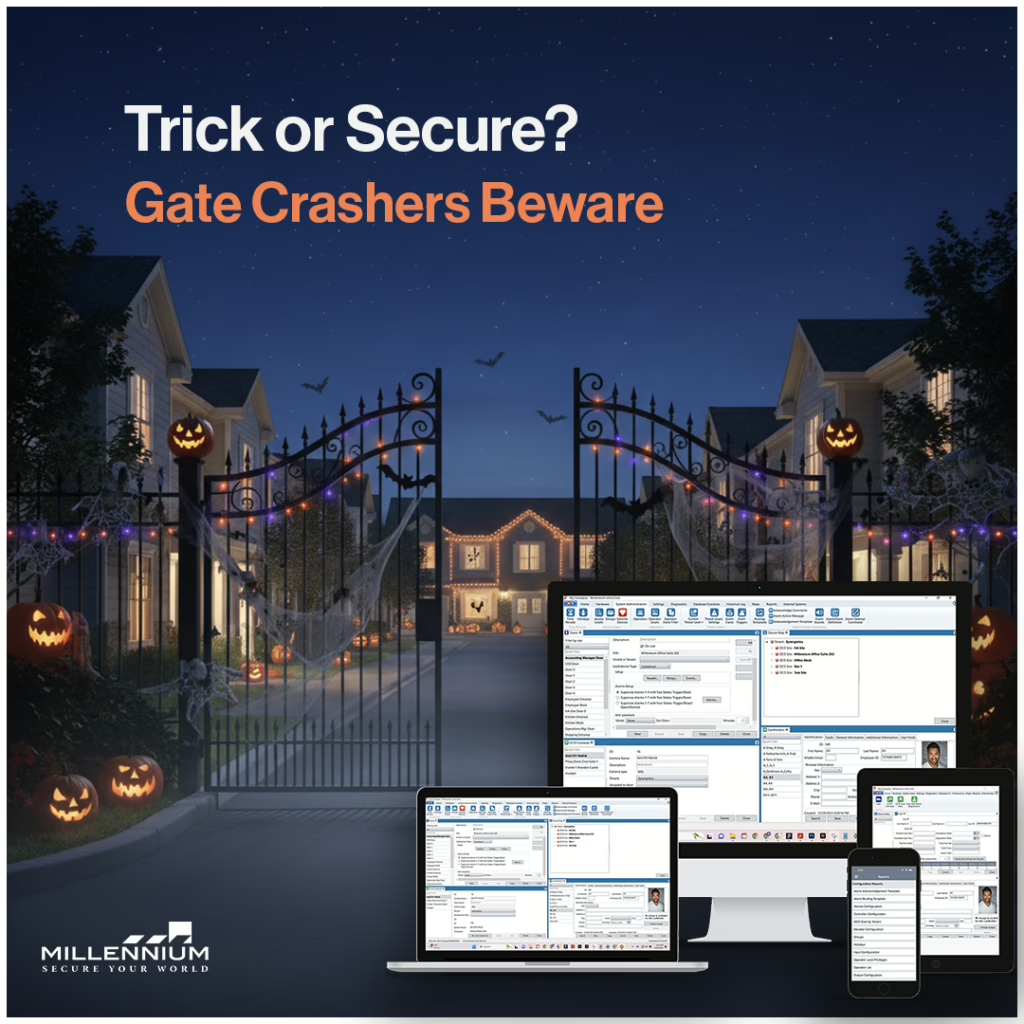
Halloween is that thrilling time of the year when costumes, candy, and spooky decorations take center stage. But while ghosts and goblins are fun for kids and adults alike, the reality of uncontrolled access to your facility can turn Halloween night into a nightmare. From unexpected visitors to mischievous gatecrashers, facilities without proper access management face risks ranging from minor disruptions to serious security breaches.Fortunately, modern access control systems can ensure your building stays secure, no matter how wild the Halloween festivities get. Let’s explore how Millennium Group Inc.’s solutions help you protect your facility from Halloween chaos. 1. Cloud-Based Access Control SystemManaging your facility’s security remotely has never been more important. With a cloud-based system, facility managers can monitor and control doors, credentials, and user activity from anywhere — even while coordinating Halloween events or checking on multiple sites. Real-time alerts ensure you never miss a security incident, keeping your facility safe from unexpected visitors.The cloud-based access control system also allows for quick configuration changes during high-traffic events. If you notice unusual activity or need to temporarily restrict access to certain areas, adjustments can be made instantly without physical intervention. This flexibility reduces response time, minimizes human error, and ensures that your facility stays protected no matter how chaotic Halloween night becomes. 2. Mobile Management / Mobile ConnectLost keycards or shared credentials are a security nightmare, especially on a night when many temporary visitors may be in your facility. Mobile credentials allow users to access doors via their smartphones, eliminating the risk of lost cards and making it easier to manage temporary access for contractors, event staff, or visitors.Mobile access control also enables personalized security settings, so employees or guests can have time-limited access to specific zones. Notifications on entry attempts provide real-time awareness, helping security teams act immediately if suspicious activity is detected. This reduces risks associated with manual key distribution and ensures smooth operations even during heavily trafficked Halloween events. 3. Scalable FlexibilityHalloween events can draw crowds, and your facility may need to expand access temporarily. Millennium Group’s solutions offer scalable flexibility, allowing you to add doors, zones, or temporary users without overhauling your existing system. Whether it’s a small office or a multi-floor complex, your access control can grow with your needs.This scalability also allows for integration with event-specific setups, such as pop-up activity zones or temporary offices. You can manage multiple entrances, allocate staff credentials dynamically, and even segment visitor flows for efficiency. Scalable systems ensure that no area is left unsecured, and everyone in the facility has the proper access level during busy Halloween nights. 4. Seamless Integration with Existing HardwareWorried about replacing your current infrastructure? Millennium’s systems integrate seamlessly with existing hardware, meaning you can upgrade your security without ripping out locks or wiring. Even older facilities can benefit from modern access control without major disruptions.Integration minimizes downtime and reduces installation costs, while allowing your facility to leverage both new and legacy components. This compatibility ensures that critical areas remain protected during the transition and that your security team can maintain full control. On Halloween, when large events may strain resources, seamless integration prevents security gaps caused by incompatible hardware. 5. Visitor Management / Badging & IdentificationHalloween often brings unexpected visitors. Proper visitor management ensures everyone entering your facility is registered and identifiable. From badging to temporary credentials, these features prevent uninvited guests — or mischievous “gatecrashers” — from wandering freely inside.Advanced visitor management also allows pre-registration, automatic check-ins, and notifications to hosts when guests arrive. Temporary credentials can expire automatically, eliminating security loopholes. During Halloween, this ensures that even with a high volume of visitors, staff know exactly who is inside the facility, reducing the risk of unauthorized access and potential disruptions. 6. Video Surveillance / CCTV IntegrationPairing access control with video surveillance gives your eyes on every corner. Unauthorized movement, unusual activity, or suspicious visitors can be detected instantly, helping prevent property damage or theft. On Halloween, this is especially useful when decorations, equipment, or event setups may otherwise distract staff from monitoring.Surveillance footage can be integrated with access logs to quickly identify and verify suspicious activity. Real-time alerts and remote monitoring allow security teams to respond immediately, even if they are not on-site. This layer of protection ensures accountability, deters misbehavior, and maintains a secure environment throughout Halloween festivities. Download the Cloud Access Control Checklist your 15-step, printable guide to building a secure, scalable, and cloud-ready system. Includes: PoLP setup, MFA guide, permission audit worksheet + a bonus printable template. Click Here 7. Smart Locks & Wireless Control Devices Mechanical locks are no match for opportunistic intruders. Smart locks and wireless devices allow dynamic control of entry points, so you can lock down sensitive areas quickly or adjust access levels on the fly. This flexibility is invaluable when managing multiple events, floors, or departments.Smart locks can be programmed to allow temporary or recurring access without issuing physical keys. Wireless controls also facilitate remote lock/unlock actions and system health monitoring. During Halloween, this ensures critical areas remain restricted while public areas remain accessible, balancing security and convenience for staff and visitors alike. 8. Emergency Lockdown / Restricted AccessIf an incident occurs — like unauthorized entry or misbehavior — emergency lockdown features can secure critical areas immediately. You can restrict access in real time, keeping people safe andLockdown protocols can be customized for different scenarios, such as intruder detection or overcrowding in a specific area. Alerts can be automatically sent to security personnel and facility managers, providing immediate guidance. This feature ensures rapid containment of threats, keeping both people and property safe during high-risk Halloween situations. 9. Parking / Parking Access Control SystemGatecrashers often start in the parking lot. Parking access control ensures that only authorized vehicles can enter, reducing the risk of car theft, overcrowding, or accidents during Halloween events.Advanced parking access control systems can monitor occupancy, manage visitor parking passes, and prevent unauthorized vehicles from entering sensitive areas. Integration with access control and security cameras provides a complete view of vehicle movement. On Halloween, this keeps parking areas orderly, prevents
Rethinking Campus Security: What Georgia’s House Bill 268 Means for Your Access Control Plan
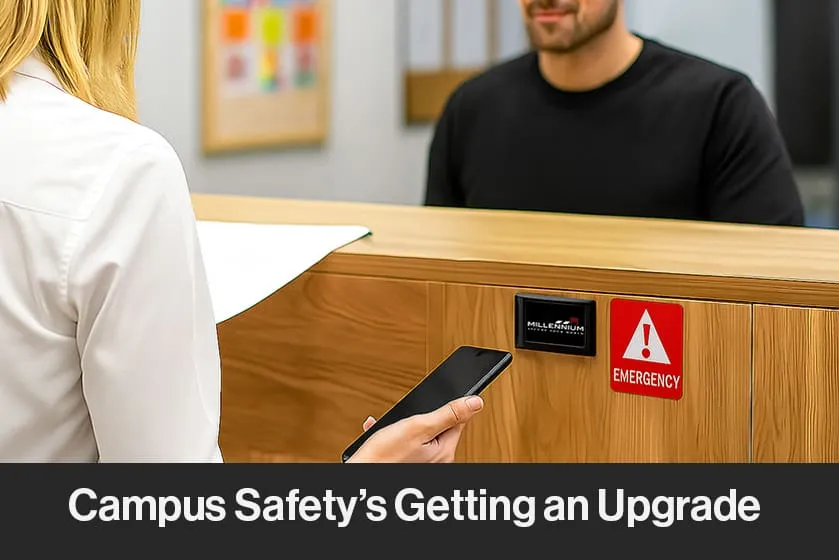
As the academic year gears up, a new wave of school safety legislation is reshaping how educational institutions think about security. But rather than stirring fear, these regulations present an exciting opportunity: to modernize and unify your access control system strategies in ways that not only enhance safety but also improve day-to-day operations. In short, smart campuses are becoming safe campuses—and it’s time to understand how. The New Landscape of School Security Georgia’s House Bill 268 has become a landmark piece of legislation, setting new standards for school safety across the state. Designed to proactively prepare institutions for a wide range of threats, the bill emphasizes integrated technologies and collaboration between schools and emergency services. It has also sparked broader national conversations on best practices in campus security, from real-time mapping to wearable alert systems. Recent legislative developments, such as Georgia’s House Bill 268, are ushering in a proactive era of school security. This law, among other mandates, requires schools to: Equip staff with wearable panic alert systems Digitally map campus facilities for emergency responders Coordinate with law enforcement on student behavior threats Improve the speed and accuracy of record transfers across districts Meanwhile, in Florida, the state’s Marjory Stoneman Douglas High School Public Safety Commission has recommended clarification around door locking mechanisms in classrooms. Their goal: ensure that doors can be securely locked from the inside without key access and without creating new security or code compliance issues. These recommendations echo a broader national push for intuitive, accessible lockdown capabilities and standardized safety measures in every school. These changes are designed to ensure quicker responses and better coordination in emergencies. But beyond compliance, they highlight the critical need for integrated access control system solutions that make all of this possible. Access Control: The Heart of a Safer Campus In the context of these new regulations, access control technology takes center stage. A smart access system is no longer a “nice-to-have” but a foundational element of modern campus safety. Key Features Schools Should Prioritize: Cloud-Based Access Management Centralized control across multiple buildings and campuses Instant credential updates and revocations from any device Integrations with other systems (HR, student records, emergency platforms) Real-Time Monitoring, Custom Alerts & Incident Response Live dashboard. Automatic alerts for unauthorized entry attempts or door breaches Custom alert triggers based on zones, time of day, or individual access history Custom schedules based on bell times, holidays, and after-school activities Mobile Credentials for Staff and Students Secure, encrypted access via smartphones or wearables Real-time updates without reissuing hardware Visitor Management Registration for guests with background screening options Digital sign-in with driver’s license scanning for quick verification Temporary credentials issued digitally, avoiding manual sign-in sheets Real-time tracking and audit trails for every visitor entry and exit Revocation of access at any time Role-Based Access Controls Tailored permissions for faculty, administration, maintenance, and vendors Automatic updates when roles change Emergency overrides for first responders Geo-Fencing and Emergency Response: Taking Access Control to the Next Level Every second counts in an emergency. Rapid, decisive action can make all the difference—which is why geo-fencing and mobile-triggered lockdown capabilities are transforming how educational institutions manage crises. Using NFC tags and mobile devices, administrators can instantly: Tap and Activate: Secure entry points and initiate lockdown for designated zones using smartphones. Trigger Alarms: Notify campus security and emergency responders in real time. Extend Lockdown: Scale response from one area to multiple buildings with a single action. These smart features not only provide flexible emergency response but also integrate seamlessly with existing door controllers and access points. Pre-programmed tags placed at strategic locations—like podiums or desks—enable instant, intuitive action. Whether used by staff, security, or emergency personnel, these tools bring speed and clarity to chaotic situations. Geo-fencing adds a layer of intelligence, ensuring that only authorized personnel within designated zones can initiate responses. Combined with mobile credentials and customizable emergency tags, it forms a comprehensive solution for both proactive safety and reactive emergency management. All actions are logged in a detailed historical audit trail, allowing administrators to review response times, access events, and system performance after an incident. Digital Mapping Meets Physical Security One of the most impactful components of new legislation is the requirement for up-to-date digital campus maps. These maps, when integrated with access control systems, can revolutionize emergency response. Imagine this: A fire alarm goes off in Building C. Emergency personnel pull up a real-time digital map showing every access point, its current status, and the location of individuals inside. Instead of relying on static floorplans, responders have a dynamic view, helping them act faster and more accurately. Access control systems that support mapping integrations ensure that safety doesn’t stop at the badge reader. It extends to live coordination and situational awareness. Download the Cloud Access Control Checklist your 15-step, printable guide to building a secure, scalable, and cloud-ready system. Includes: PoLP setup, MFA guide, permission audit worksheet + a bonus printable template. Click Here Beyond Security: Operational Benefits for Educational Institutions While these access control features bolster safety, they also bring operational efficiency to the forefront. Streamlined Student Transfers: Digital credentials and audit trails simplify record verification and hand-offs between districts. Cost Savings Over Time: Cloud-based systems reduce reliance on physical keys, lower maintenance needs, and eliminate the expense of rekeying buildings. Improved Facility Management: Access logs inform space utilization, helping schools make smarter scheduling and infrastructure decisions. Compliance Made Easy: Automated reporting tools simplify audits and keep institutions aligned with state and federal mandates. Efficient Visitor Flow: A digital-first visitor system ensures guests are identified, logged, and given access quickly—without compromising security protocols. Creating a Culture of Safety Through Simplicity The best access control system solutions don’t just work in the background—they empower the people using them. For faculty and staff, mobile credentials mean no more lost badges or confusing keychains. For administrators, cloud-based dashboards offer clarity and control. For parents and students, visible security builds trust. And when training is minimal and interfaces are intuitive, everyone on campus
Vacant Property Security: How to Protect Homes That Are 50% More Likely to Be Targeted
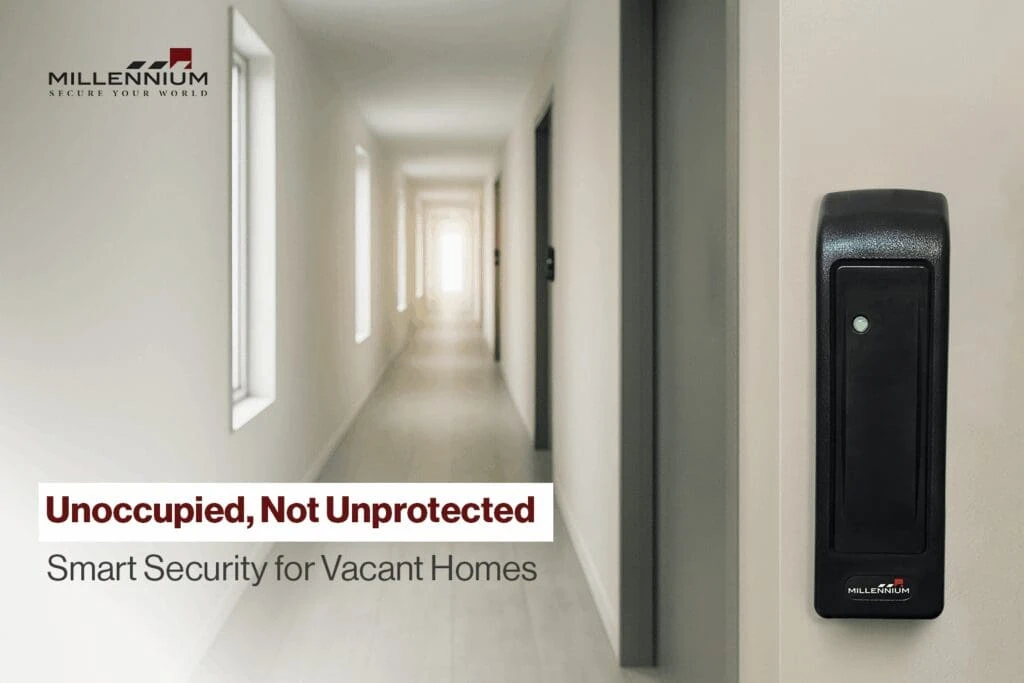
Whether you’re managing a rental unit between tenants, selling a home, or maintaining a seasonal vacation property, vacant property security should be a top priority. Unoccupied homes are prime targets for break-ins, vandalism, squatters, and even structural damage due to undetected leaks or electrical faults. According to the National Crime Prevention Council, “vacant homes are up to 50% more likely to be targeted by intruders than occupied ones.” Fortunately, modern home security systems make securing vacant property more effective, smarter, and easier than ever before. With advances in smart security systems, you can now safeguard your investment remotely and maintain peace of mind. Protecting vacant homes is not just a security concern but a financial one as well. Why Vacant Properties Are High-Risk A property left vacant for weeks or months becomes increasingly vulnerable. Without daily activity or visible signs of occupancy, criminals can quickly identify easy targets. According to law enforcement agencies, vacant homes are significantly more likely to experience burglary or unauthorized entry than occupied ones. Risks include theft of appliances, copper pipes, or HVAC systems; vandalism and graffiti; illegal occupancy or squatting; and water damage from undetected leaks. Additionally, fire hazards, pest infestations, mold, and insurance complications all increase the danger. These risks make vacant property security essential for any homeowner. The lack of human presence invites threats that even a locked door can’t stop. Properly securing vacant property involves anticipating both environmental and criminal threats before they strike. Essential Home Security Solutions for Securing Vacant Property Investing in the right smart security technology can drastically reduce the risk of costly damage or intrusion. Here are some top solutions that can help in securing vacant property efficiently: 24/7 Smart Surveillance Cameras Install motion-activated cameras with night vision and cloud-based video storage. Live viewing capabilities allow property owners to monitor the site from anywhere in real time. These cameras can be integrated into a mobile app, providing round-the-clock vigilance and incident recording. Vacant property security starts with visibility, and surveillance provides just that. The presence of visible cameras alone can act as a strong deterrent against trespassers. Some advanced cameras also include AI-based analytics to detect loitering, unusual movement, or license plate recognition for vehicles entering the premises. For property managers overseeing multiple locations, this can dramatically reduce the burden of manual monitoring while ensuring every vacant site is properly protected. Remote Access Control Systems Use digital locks or keyless entry systems that can be managed remotely. This allows property managers to grant or revoke access to contractors or inspectors without physically being present. It also prevents the risk of lost keys or unauthorized duplication. Securing vacant property becomes easier and safer with tech-enabled access control. In addition, access events are logged and time-stamped, creating a complete record of who entered the property and when—useful for both security and liability management. Some systems offer multi-factor authentication, ensuring only verified personnel can gain entry. Combined with mobile app notifications, remote access control gives owners real-time awareness and the ability to take immediate action if unauthorized activity is detected. Intrusion Detection Alarms A robust alarm system with door/window sensors, glass break detectors, and tamper alerts ensures that any unauthorized access is immediately detected and reported. Real-time alerts via text or email ensure a swift response. Alarms are central to any vacant property security setup. Many systems today offer cellular backup and battery redundancy to ensure coverage even during power outages or internet disruptions. For more advanced setups, intrusion detection can be integrated with video verification, allowing property owners to confirm whether a breach is real or a false alarm. Smart alarms can also communicate with law enforcement or security teams, automating the dispatch process and improving emergency response time when every second matters. Environmental Sensors Smart sensors can detect smoke, CO2, flooding, or extreme temperatures—issues that might go unnoticed in an unoccupied property but can lead to major damage. Securing vacant property means defending against natural threats as well as intrusions. Download the Cloud Access Control Checklist your 15-step, printable guide to building a secure, scalable, and cloud-ready system. Includes: PoLP setup, MFA guide, permission audit worksheet + a bonus printable template. Click Here Automated Lighting and Timers Use smart lighting to simulate occupancy. Randomized schedules for indoor and outdoor lights can deter criminals who look for signs of vacancy. This affordable and effective tactic strengthens your vacant property security strategy. Securing Vacant Property in 2025: It’s About Integration The future of vacant property security lies in integrated systems that combine video, access control, intrusion detection, and automation into one seamless platform. These systems provide real-time alerts, historical logs, and scalable control across multiple properties—all from a single dashboard. With the evolution of AI-powered analytics, security platforms can now recognize unusual behavior, track patterns, and reduce false alarms. Integration not only simplifies operations but enhances accuracy and response speed. For those responsible for securing vacant property, integrated solutions are no longer optional—they’re the gold standard. Why Millennium Ultra Is the Future of Vacant Property Security For property owners and managers looking for a professional-grade solution, Millennium Ultra from MGI Access delivers industry-leading performance. Millennium Ultra is an advanced access control platform that integrates seamlessly with modern security tools—cameras, sensors, alarms, and building automation. It provides centralized control for multiple sites, real-time activity monitoring, and customizable user permissions, making it ideal for vacant property security applications. Whether you’re managing one unoccupied home or an entire portfolio of vacant properties, Millennium Ultra ensures secure, scalable, and smart control. It’s the smart choice for securing vacant property in today’s unpredictable world. Case Study: Securing a Vacant Home in Boston In 2024, a property owner in Boston faced repeated vandalism and trespassing incidents at a vacant brownstone listed for sale. Despite traditional locks and neighborhood watch efforts, the home suffered thousands of dollars in damage. The owner turned to Millennium Ultra for help. After installing integrated surveillance, remote access controls, and smart sensors, incidents stopped completely. The platform allowed the owner to view
Crowd Management & Access Control for Summer Events and Festivals
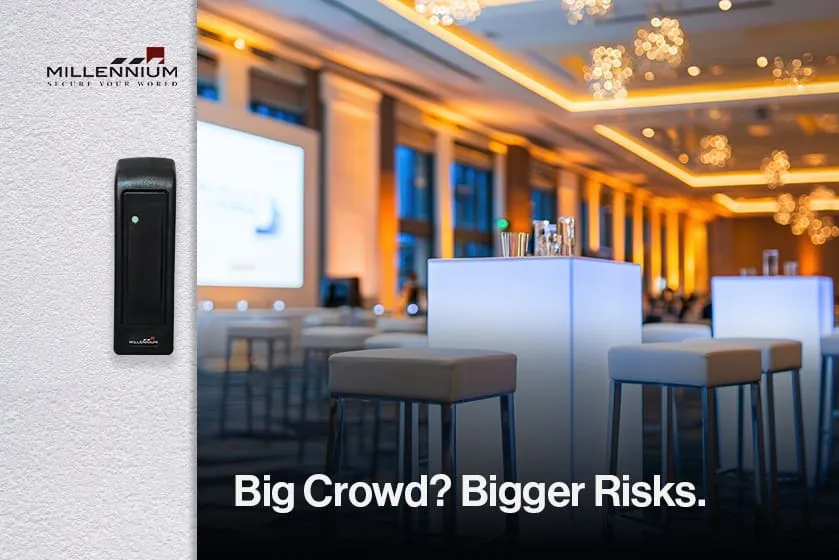
Summer is the peak moving season for multifamily buildings, student housing, and short-term rentals. As tenants move in and out, property managers face the challenge of keeping security tight while juggling high turnover. During this busy period, the right smart access control strategy isn’t just a convenience—it’s a necessity. This blog explores how to use cloud-based, scalable access control systems to manage seasonal transitions smoothly and securely while strengthening rental property security. From entry management to audit logs, everything contributes to stronger rental property security. Why Summer Demands Smarter Access Control The numbers tell the story: According to the U.S. Census Bureau, over 40% of all residential moves occur between May and August. That spike in activity brings increased risk of: Rental property security is no longer optional—it’s expected by modern tenants. Lost or duplicated keys Delays in reissuing physical credentials Unauthorized access from former tenants Increased foot traffic from guests and service providers This is where a smart, modern access control system shines. With features like remote credential management, mobile access, and real-time auditing, property managers can respond faster, reduce manual work, and enhance building security during the busiest months of the year. For multifamily units, rental property security must scale with tenant needs and expectations. Replace Physical Keys with Mobile Credentials Managing physical keys during turnover can be a logistical nightmare. Keys are often lost, copied, or never returned, forcing managers to rekey locks at a high cost. With mobile credentials: Tenants receive digital access via smartphone apps Access can be revoked instantly when a lease end No hardware changes are needed between residents Mobile access is not only more secure; it also aligns with modern tenant expectations—especially among younger renters who prefer digital-first amenities. A report by Entrata found that 72% of residents aged 18–34 say smart home features, including mobile access, influence their leasing decisions. Offering this convenience can enhance marketability and retention. Together, these features eliminate the inefficiencies of traditional key systems and significantly improve rental property security, especially during periods of frequent tenant change. Automate and Schedule Access in Advance Smart access systems allow managers to pre-configure access for new residents before move-in day. With scheduled activation: Access begins precisely when the lease starts Cleaners or maintenance staff can receive temporary access ahead of time No need to coordinate in-person handoffs or change locks between moves This reduces friction on move-in day, improves operational efficiency, and frees up time for other critical tasks. It also ensures that incoming tenants feel welcomed and secure from day one. Track Access in Real Time to Prevent Unauthorized Entry During summer transitions, the line between tenants, guests, and vendors can blur. A cloud-based access control system provides clear oversight with: Real-time access logs showing who entered and when Alerts for unauthorized or unusual access attempts Reports that help identify patterns or potential risks In large student housing complexes or short-term rental units, this visibility can deter unauthorized subletting, overcrowding, or after-hours activity in shared spaces. This level of insight not only improves operational control but also enhances rental property security by ensuring only authorized individuals access the premises at all times. Streamline Offboarding with Instant Credential Revocation When a tenant moves out, access revocation must be immediate to prevent unwanted entry. With smart access control: Mobile or key fob credentials can be deactivated remotely Managers don’t need to collect physical keys Former tenants can’t duplicate or misuse access This also simplifies legal compliance—some jurisdictions require that keys or access rights be revoked within a certain window after lease termination. Integrate with Other Building Systems Modern access control systems can sync with other platforms like property management software, CCTV, and intercoms. This integration enables: One-click onboarding and offboarding Unified tenant databases Seamless video verification during access events For example, a new resident entered into the property management system can automatically receive digital credentials without redundant data entry. This reduces errors and helps teams scale without growing administrative burden. Download the Cloud Access Control Checklist your 15-step, printable guide to building a secure, scalable, and cloud-ready system. Includes: PoLP setup, MFA guide, permission audit worksheet + a bonus printable template. Click Here Reduce Liability and Increase Transparency In peak turnover seasons, disputes can arise around move-out dates, security deposits, and damages. An integrated access control system provides: Timestamped logs for when tenants vacated Entry data that supports enforcement of late fees or early move-ins Documentation for insurance or legal cases These systems create a digital paper trail that helps protect both residents and property teams. Secure Shared Amenities and Common Areas High tenant turnover often leads to shared spaces being overused, misused, or accessed by unauthorized individuals. Smart access systems can control access to: Gyms, clubhouses, and lounges Rooftop decks or barbecue areas Package rooms and storage lockers Setting time-based or role-based permissions ensures only eligible tenants can use these spaces during designated hours. This boosts fairness, reduces damage, and builds community trust. Scale Easily for High Volume Transitions Cloud-based systems are ideal for buildings that handle dozens—or hundreds—of summer move-ins and move-outs. With centralized dashboards and batch credential assignment, staff can: Manage multiple units or buildings from one interface Assign access based on unit number, lease term, or role Minimize human error during mass onboarding periods Whether managing one building or an entire portfolio, the platform scales with your needs. Provide a Better Resident Experience Residents today expect frictionless, tech-enabled services. With smart access control, your building can offer: Self-guided tours for prospective renters Mobile entry for new residents on day one Fast, contactless maintenance access This creates a more professional, responsive, and modern tenant experience—something that boosts reviews, referrals, and retention. Adapt to Short-Term and Vacation Rentals With the rise of vacation rentals and platforms like Airbnb, many properties experience rapid guest turnover, especially in the summer. Smart access control helps by: Assigning temporary, expiring credentials for each booking Automating access rules based on check-in/check-out times Integrating with booking systems to reduce administrative tasks This ensures security
Summer Tenant Turnover? Boost Rental Property Security Smartly
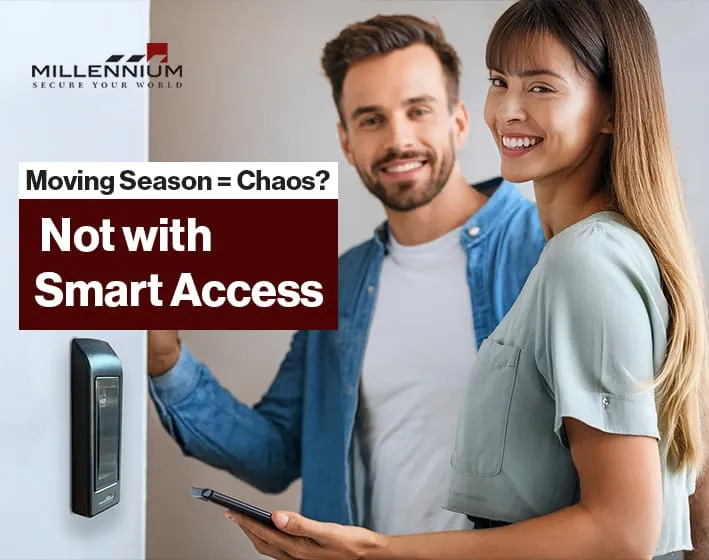
We often say, “safety first”—but in the world of real estate, property management, and facility operations, proof of safety matters more than ever. You might already be running a tight ship: your cameras are up, your access control system is fully functional, and your maintenance logs are squeaky clean. But here’s a question you might not have asked lately: Does Anyone Outside Your Team Know That? Recognition isn’t just about ego or awards. It’s about visibility, trust, compliance—and yes, profitability. We live in a world where perception drives decision-making. If people don’t see your building as safe, they won’t treat it that way. Whether you manage a commercial property, a multifamily complex, or a government facility, your building’s security reputation can impact occupancy, tenant satisfaction, insurance rates, and even your property’s market value. Let’s break down why being recognized for your building’s safety matters, what programs are available, and how it can help you stand out in a crowded market. Safety Is a Selling Point—But Only If People Know About It Common question: “We already have great security—do we really need to advertise it?” Short answer: Yes. Because perception drives behavior. In a recent survey by NMHC, over 82% of renters said that security features were a top factor in choosing where to live. But it’s not enough to just have security—you need to showcase it. Here’s the thing: tenants rarely ask to see your technical specs. They want to feel secure, and that starts with visible systems, clear policies, and proud presentation. What you can do: Use signage that highlights your 24/7 surveillance and access control system. Add security protocols to your lease agreements and welcome brochures. Give security tours—just like you would for amenities like the gym or rooftop lounge. Post tenant reminders during holidays or events to show proactive safety planning. Bonus tip? Record short videos of your safety walkthroughs and post them on your website or social channels. It turns your security into a marketing asset, not just a liability line item. Certifications Are More Than Stickers—They Signal Operational Maturity Common question: “Do certifications really make a difference?” Absolutely. Especially when you’re managing risk, securing funding, or trying to win over stakeholders who don’t see security as “glamorous.” Certifications give your safety claims credibility. Whether it’s an industry standard or a local recognition program, it tells others: “We don’t just talk about safety—we prove it.” You might consider: UL 294 / UL 2050: For commercial-grade access control systems and electronic security components. Crime-Free Housing programs: For multifamily or student housing. LEED + WELL certifications: If sustainability and well-being are part of your brand. Local Safe Site Programs: Some municipalities offer these in partnership with law enforcement. These aren’t just badges—they’re trust builders. They also open doors to faster permitting, better insurance premiums, and a smoother tenant onboarding experience. Recognition Improves Stakeholder Relationships (and Budget Conversations) Common question: “How do I get leadership to invest in security upgrades?” We get it—security doesn’t always get top billing in budget meetings. But when you show that your security program has external validation, it reframes the discussion. Instead of saying, “We need a better camera,” you’re now saying: “We’ve been nominated for a regional Safe Property award—and with one more investment in access control, we can win it next year.” It changes the narrative. Here’s how you can build the case: Track KPIs like door event logs, alarm incidents, and access attempts. Compile a one-page quarterly report showing improvements. Add third-party comments from vendors or inspectors to your presentation deck. Tie access control directly to tenant satisfaction surveys or online reviews. By proving your program’s impact and credibility, you’re not just asking for money—you’re presenting a strategy. Download the Cloud Access Control Checklist your 15-step, printable guide to building a secure, scalable, and cloud-ready system. Includes: PoLP setup, MFA guide, permission audit worksheet + a bonus printable template. Click Here It Can Directly Impact Your Bottom Line Common question:“Will this recognition really improve ROI?” It’s easy to forget how many areas safety touches: Tenant retention: Safe buildings = loyal tenants. People rarely renew if they feel unsafe. Faster lease-ups: Security features often tip the scale in multifamily and office leases. Reduced liability: In the event of a security incident, documented protocols can help limit exposure. Higher appraisals: Smart buildings with reliable access control systems command higher value in the eyes of investors and buyers. And here’s a fresh angle: branding. Imagine having a plaque in your lobby that says, “Certified Safe by [Local Authority or Partner Program].” Or an online badge on your property’s website. It’s more than feel-good PR—it’s a positioning tool that separates you from the building down the street. Recognition Builds Confidence and Legal Protection Common question:“We haven’t had any incidents—why should we fix what isn’t broken?” Because in today’s world, being reactive is risky business. When something does go wrong, the first question will be: “What had been done to prevent this?” Recognition shows a proactive, transparent approach to risk management. It proves you followed the best practices available. In a legal or PR crisis, this documentation and third-party verification may be your best defense. Even more importantly, it builds community trust. Tenants are more likely to report suspicious activity or follow safety rules when they know you take it seriously. Final Takeaway: Don’t Just Be Secure—Be Seen as Secure We’re not saying you need to chase trophies. But we are saying this: visibility in your security strategy adds real-world value. A modern access control strategy, when layered with surveillance, training, and third-party recognition, transforms your building from just “another property” into a respected, trusted, and preferred destination. Want to Learn What Recognition Could Look Like for Your Facility? Millennium helps buildings move beyond basic access control. We partner with property managers, IT leads, and operations teams to assess, elevate, and even certify your system’s safety level—whether you’re managing five doors or five campuses. Let us show you how a future-ready access
“Safety First” Isn’t Just a Slogan—Here’s Why Your Building Needs to Prove It
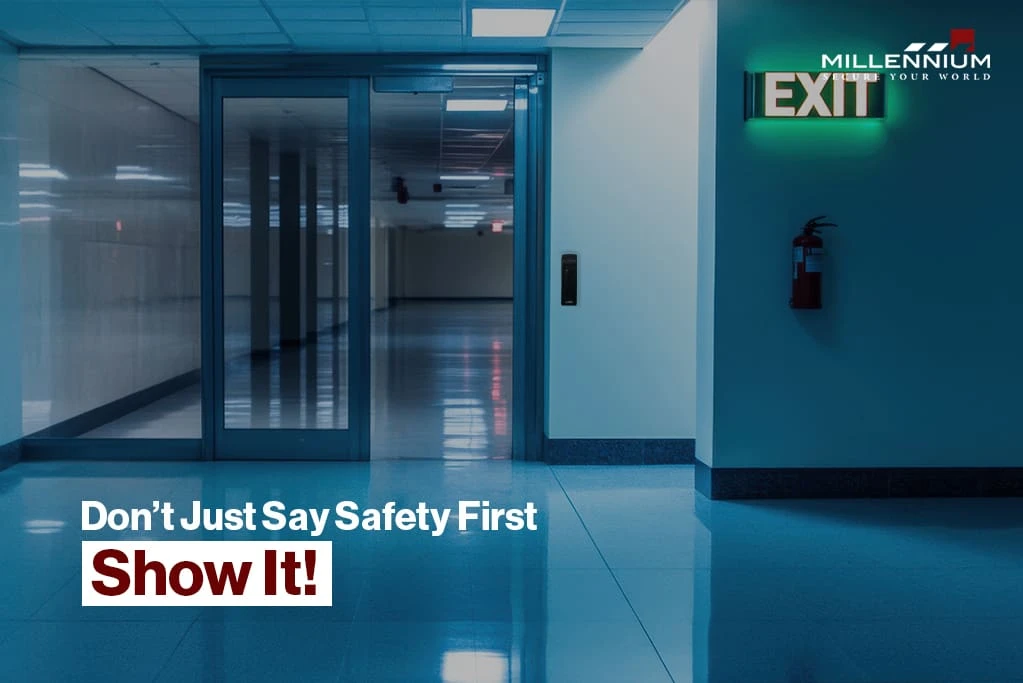
We often say, “safety first”—but in the world of real estate, property management, and facility operations, proof of safety matters more than ever. You might already be running a tight ship: your cameras are up, your access control system is fully functional, and your maintenance logs are squeaky clean. But here’s a question you might not have asked lately: Does Anyone Outside Your Team Know That? Recognition isn’t just about ego or awards. It’s about visibility, trust, compliance—and yes, profitability. We live in a world where perception drives decision-making. If people don’t see your building as safe, they won’t treat it that way. Whether you manage a commercial property, a multifamily complex, or a government facility, your building’s security reputation can impact occupancy, tenant satisfaction, insurance rates, and even your property’s market value. Let’s break down why being recognized for your building’s safety matters, what programs are available, and how it can help you stand out in a crowded market. Safety Is a Selling Point—But Only If People Know About It Common question: “We already have great security—do we really need to advertise it?” Short answer: Yes. Because perception drives behavior. In a recent survey by NMHC, over 82% of renters said that security features were a top factor in choosing where to live. But it’s not enough to just have security—you need to showcase it. Here’s the thing: tenants rarely ask to see your technical specs. They want to feel secure, and that starts with visible systems, clear policies, and proud presentation. What you can do: Use signage that highlights your 24/7 surveillance and access control system. Add security protocols to your lease agreements and welcome brochures. Give security tours—just like you would for amenities like the gym or rooftop lounge. Post tenant reminders during holidays or events to show proactive safety planning. Bonus tip? Record short videos of your safety walkthroughs and post them on your website or social channels. It turns your security into a marketing asset, not just a liability line item. Certifications Are More Than Stickers—They Signal Operational Maturity Common question: “Do certifications really make a difference?” Absolutely. Especially when you’re managing risk, securing funding, or trying to win over stakeholders who don’t see security as “glamorous.” Certifications give your safety claims credibility. Whether it’s an industry standard or a local recognition program, it tells others: “We don’t just talk about safety—we prove it.” You might consider: UL 294 / UL 2050: For commercial-grade access control systems and electronic security components. Crime-Free Housing programs: For multifamily or student housing. LEED + WELL certifications: If sustainability and well-being are part of your brand. Local Safe Site Programs: Some municipalities offer these in partnership with law enforcement. These aren’t just badges—they’re trust builders. They also open doors to faster permitting, better insurance premiums, and a smoother tenant onboarding experience. Recognition Improves Stakeholder Relationships (and Budget Conversations) Common question: “How do I get leadership to invest in security upgrades?” We get it—security doesn’t always get top billing in budget meetings. But when you show that your security program has external validation, it reframes the discussion. Instead of saying, “We need a better camera,” you’re now saying: “We’ve been nominated for a regional Safe Property award—and with one more investment in access control, we can win it next year.” It changes the narrative. Here’s how you can build the case: Track KPIs like door event logs, alarm incidents, and access attempts. Compile a one-page quarterly report showing improvements. Add third-party comments from vendors or inspectors to your presentation deck. Tie access control directly to tenant satisfaction surveys or online reviews. By proving your program’s impact and credibility, you’re not just asking for money—you’re presenting a strategy. Download the Cloud Access Control Checklist your 15-step, printable guide to building a secure, scalable, and cloud-ready system. Includes: PoLP setup, MFA guide, permission audit worksheet + a bonus printable template. Click Here It Can Directly Impact Your Bottom Line Common question:“Will this recognition really improve ROI?” It’s easy to forget how many areas safety touches: Tenant retention: Safe buildings = loyal tenants. People rarely renew if they feel unsafe. Faster lease-ups: Security features often tip the scale in multifamily and office leases. Reduced liability: In the event of a security incident, documented protocols can help limit exposure. Higher appraisals: Smart buildings with reliable access control systems command higher value in the eyes of investors and buyers. And here’s a fresh angle: branding. Imagine having a plaque in your lobby that says, “Certified Safe by [Local Authority or Partner Program].” Or an online badge on your property’s website. It’s more than feel-good PR—it’s a positioning tool that separates you from the building down the street. Recognition Builds Confidence and Legal Protection Common question:“We haven’t had any incidents—why should we fix what isn’t broken?” Because in today’s world, being reactive is risky business. When something does go wrong, the first question will be: “What had been done to prevent this?” Recognition shows a proactive, transparent approach to risk management. It proves you followed the best practices available. In a legal or PR crisis, this documentation and third-party verification may be your best defense. Even more importantly, it builds community trust. Tenants are more likely to report suspicious activity or follow safety rules when they know you take it seriously. Final Takeaway: Don’t Just Be Secure—Be Seen as Secure We’re not saying you need to chase trophies. But we are saying this: visibility in your security strategy adds real-world value. A modern access control strategy, when layered with surveillance, training, and third-party recognition, transforms your building from just “another property” into a respected, trusted, and preferred destination. Want to Learn What Recognition Could Look Like for Your Facility? Millennium helps buildings move beyond basic access control. We partner with property managers, IT leads, and operations teams to assess, elevate, and even certify your system’s safety level—whether you’re managing five doors or five campuses. Let us show you how a future-ready access

